Mary Anne Yarde's Blog: The Coffee Pot Book Club , page 111
December 11, 2019
#BookReview — Katherine: Tudor Duchess (Brandon Trilogy #3) by Tony Riches #HistoricalFiction #Tudors @tonyriches
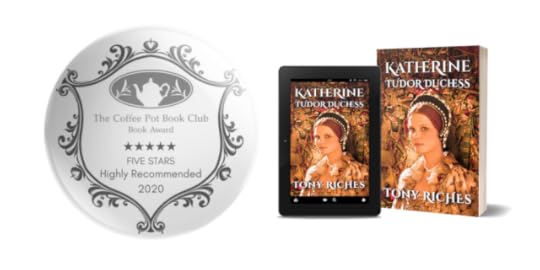
Katherine: Tudor Duchess(Brandon Trilogy #3)By Tony Riches

Attractive, wealthy and influential, Katherine Willoughby is one of the most unusual ladies of the Tudor court. A favourite of King Henry VIII, Katherine knows all his six wives, his daughters Mary and Elizabeth and his son Edward.
When her father dies, Katherine becomes the ward of Tudor knight, Sir Charles Brandon. Her Spanish mother, Maria de Salinas, is Queen Catherine of Aragon’s lady in waiting, so it is a challenging time for them all when King Henry marries the enigmatic Anne Boleyn.
Following Anne’s dramatic downfall, Katherine marries Charles Brandon, and becomes Duchess of Suffolk at the age of fourteen. After the short reign of young Catherine Howard, and the tragic death of Jane Seymour, Katherine and Brandon are chosen to welcome Anna of Cleves as she arrives in England.
When the royal marriage is annulled, Katherine’s good friend, Catherine Parr becomes the king’s sixth wife, and they work to promote religious reform. Katherine’s young sons are tutored with the future king, Prince Edward, and become his friends, but when Edward dies his Catholic sister Mary is crowned queen. Katherine’s Protestant faith puts her family in great danger - from which there seems no escape.
Katherine’s remarkable true story continues the epic tale of the rise of the Tudors, which began with the best-selling Tudor trilogy and concludes with the reign of Queen Elizabeth I.

"This is an opportunity most girls of your age can only dream of..."
But nine-year-old Katherine Willoughby has no desire to leave her beloved Parham Hall, the place where she had been born. However, although tender in years, Katherine knows that her desires will not be taken into consideration. King Henry has sold her wardship to his brother-in-law, Sir Charles Brandon, 1st Duke of Suffolk, and there is nothing Katherine nor anyone else can do about it.
To her surprised delight, Westhorp Hall soon feels like home. Katherine gets on well with Brandon's daughters, Frances and Eleanor, and she finds another mother in Lady Mary, who had very briefly, before her marriage to Brandon, been the Queen consort of France.
Katherine's future is secure. When they both came of age, Katherine will marry Henry Brandon, 1st Earl of Lincoln. It will be a good marriage, even if Katherine did think of young Henry as nothing other than a brother. But with Lady Mary's death comes a new and unexpected proposal. At fourteen she finds herself married to the recently widowed forty-nine-year-old, Duke of Suffolk.
From the comforts and familiarity of Parham Hall to the desperate flight across Europe to escape the persecution of Queen Mary I, Katherine: Tudor Duchess (Brandon Trilogy #3) by Tony Riches is the compelling account of the life of one of England's greatest heiresses.
After the success of Riches' The Tudor Trilogy, I was delighted to find out that he planned to write a trilogy on the life of Charles Brandon and his wives. The first two books of this trilogy were everything I had come to expect from Riches. Riches is an author that a reader can rely on to deliver. He is a vivacious storyteller, and his style of writing and his authority on the history of this period is evident in every word, every sentence, every paragraph. Reading Riches' books is as effortless as looking upon an intricate tapestry. It is, in all ways, splendid, dazzling in its intensity, and utterly unforgettable. I was waiting, therefore, with bated breath for the final instalment of what has been a truly captivating series.
Although Katherine Willoughby is eclipsed in many ways by her illustrious husband, her story is one of staunch belief, sharp intelligence, and a thirst for knowledge. In a time of religious upheaval, Katherine embraces the English Reformation. Her strength of character would see her through some very dark and dangerous times. Through Katherine's eyes, we witness Henry VIII's Court in all its golden splendour, but we also see the more ominous and uglier side. This was a time when life was cheap and being in favour one day meant nothing if you were out of it the next. Through Katherine, Riches lets us glimpse into the danger of being close to the throne — to quote Thomas Wyatt's circa Regna tonat (it thunders through the realms) and that is precisely the story that Riches gives his readers in this book.
Riches has depicted Katherine with not only tremendous verse and sensitivity but with a novelist eye for human detail. We meet Katherine at the tender age of nine, and we follow her as she grows up. We see her married, not once but twice. She becomes a Dutchess, a mother, a confidant, and a friend. No one could have drawn Katherine in such a splendid and mesmerising way as Riches can. Her story is absolutely irresistible.
There are, as one would expect, a host of historical characters in this book. But there are several characters, asides from Katherine, which really captured my attention. The first was Henry's sixth and last wife, Catherine Parr. Katherine's friendship with Catherine Parr was warm and very genuine. Catherine's disappointment in not being able to marry the man she loves and her fear that she would end her days a neck shorter is beautifully depicted. Catherine's wit and strength shines through this story. She was undoubtedly a wiry woman, but her story is also terribly tragic. When she finally marries the man she was in love with it turned out not to be quite the happy ending she had hoped for and certainly deserved. I thought her characterisation came across as very real in the telling, and I enjoyed reading about her very much.
I thought Riches' portrayal of Thomas Cromwell was fabulous. He is a very shrewd, yet incredibly intelligent man who Katherine fears, yet she also finds him strangely compelling. Their relationship was a fascinating contradiction. They could not have been more dissimilar and yet, for the briefest of moments, their stories entwined.
The other character whom we read an awful lot about is Bishop Stephen Gardiner. His beliefs came into direct conflict with Katherine's, and as his power grows, he became the antagonist in this story. Gardiner threatens not only the Reformation but the people who Katherine cares about. He is, from Katherine's point of view, a very grave threat. As this book is told entirely from Katherine's perspective, I thought this insight into what she more than likely thought of Gardiner was very articulate in the telling.
With a keen eye on the history of the period and an understanding of what makes a book entertaining, Riches is the ideal commentator for Katherine's story. This book is fabulous from start to finish. A real gem for those who love quality historical fiction set in the Tudor era.
I Highly Recommend.
Review by Mary Anne Yarde.The Coffee Pot Book Club.
Pick up your copy ofKatherine: Tudor DuchessAmazon UK • Amazon US
Tony Riches
 Tony Riches is a full-time UK author of best-selling historical fiction. He lives in Pembrokeshire, West Wales and is a specialist in the history of the Wars of the Roses and the lives of the early Tudors. Tony’s other published historical fiction novels include: Owen – Book One Of The Tudor Trilogy, Jasper – Book Two Of The Tudor Trilogy, Henry – Book Three Of The Tudor Trilogy, Mary – Tudor Princess, Brandon – Tudor Knight and The Secret Diary Of Eleanor Cobham. For more information about Tony’s books please visit his website tonyriches.com and his blog, The Writing Desk and find him on Facebook and Twitter.
Tony Riches is a full-time UK author of best-selling historical fiction. He lives in Pembrokeshire, West Wales and is a specialist in the history of the Wars of the Roses and the lives of the early Tudors. Tony’s other published historical fiction novels include: Owen – Book One Of The Tudor Trilogy, Jasper – Book Two Of The Tudor Trilogy, Henry – Book Three Of The Tudor Trilogy, Mary – Tudor Princess, Brandon – Tudor Knight and The Secret Diary Of Eleanor Cobham. For more information about Tony’s books please visit his website tonyriches.com and his blog, The Writing Desk and find him on Facebook and Twitter.
Published on December 11, 2019 21:00
Christmas at the Stones… with Uther and Merlin in Fifth Century Britannia by Tim Walker #Arthurian #Christmas @timwalker1666
 Christmas at the Stones… with Uther and Merlin in Fifth Century BritanniaBy Tim Walker
Christmas at the Stones… with Uther and Merlin in Fifth Century BritanniaBy Tim Walker

Stars winked in the deep blue blanket above them as the promise of dawn seeped upwards from the distant edge of the World; a golden glow that prompted the start of the ceremony. Druids holding burning brands chanted to the steady beat of hand drums as a line of riders wrapped in bearskin cloaks watched, their breath trails mingling with those of their horses, rising like the souls of the departed buried beneath, making their way in twisting streams to the netherworld.“Merlin, this had better be the sight you have much talked of,” King Uther growled, his horse stamping impatiently on the frozen earth.“My lord,” Merlin replied, “This is the dawn on midwinter day for which these stones were erected and aligned by the ancients who understood the movements of the sun and moon. We are blessed with a clear sight of the rising sun, and you will soon see it shine through yonder stone portal and light up the altar on which a sacrifice will be made to the goddess Beira for seeing us through another winter…”“My lord!” Bishop Andreus interrupted, causing Uther to turn to his left.“What is it?” Uther demanded of the shivering, tonsured priest, his white face peeping out from his cowl.“Beira is a pagan goddess of the druidic religion of the dark forests, banned by our former Roman masters,” he said through chattering teeth. “It is not long since the people bowed to the Roman god Saturn at their feast of Saturnalia…”“And what is your point?” Merlin challenged.“My point is, the Romans have now departed, taking their gods with them! The older ways of the ancients have passed into legend, banished by the one true Christian God to the dark corners of this land. I urge you to turn away from this base pagan bloodletting and embrace this day as the feast day of the birth of our savior, Jesus the Christ. For our God is the one true light of the world…”Uther raised a hand to silence him. “Save the sermon for later, bishop. Now let us bear witness to the mysteries of nature revealed to us.”The smell of incense mixed with sandalwood wafted before them as Merlin pointed, drawing Uther’s attention away from the fretting bishop towards the stone altar and the light now bathing it in an eerie glow. Three druids stepped from the shadows, each holding a struggling creature in one hand and a raised knife in the other. Fowls clucked their desperation and kids screamed as their throats were cut and their blood dripped into silver goblets. The drummers increased their tempo as men and women dressed in animal skins and masks danced around the altar where the druids chanted and held their hands up to welcome the rising sun.“This is an impressive sight,” Uther said, grinning his pleasure at Merlin. Bright yellow sunlight was illuminating a hitherto unseen ceremonial avenue bounded by rounded stones from east to west, cutting through the center of the stone circle. A golden shaft beamed through the windows of the largest pairs of standing stones on opposing sides of the circle, now in perfect alignment with the rising sun, like a bolt from the gods.“From this day onwards, our days grow longer,” Merlin said, “and hope is restored to the people after the darkness of winter, and the earth is reborn.”“You are forgiven for calling me out on such a cold night,” Uther said to Merlin, a broad smile cracking his frozen beard. He turned his horse to signal his readiness to leave and remarked to Bishop Andreus: “And, dear Bishop, we shall pray to the baby Jesus in our church, then progress to our hall where we shall raise a goblet to ALL the gods that they may grant us success in our campaign against the Saxons! Onwards!”
Adapted extract from Uther’s Destiny by Tim Walker
Tim Walker
 Tim Walker is an independent author based in Windsor, UK. His background is in marketing, journalism, editing and publications management. He began writing an historical series,A Light in the Dark Ages (set in Fifth Century Britain), in 2015, starting with Abandoned, set at the time the Romans left Britain. This was extensively revised and re-launched as a second edition in 2018.
Tim Walker is an independent author based in Windsor, UK. His background is in marketing, journalism, editing and publications management. He began writing an historical series,A Light in the Dark Ages (set in Fifth Century Britain), in 2015, starting with Abandoned, set at the time the Romans left Britain. This was extensively revised and re-launched as a second edition in 2018.Book two, Ambrosius: Last of the Romans, was published in 2017 and the third installment, Uther’s Destiny, was published in March 2018 (winner of One Stop Fiction book of the month award, April 2018). The adventure continues from March 2019 in the fourth book, Arthur, Dux Bellorum.
His creative writing journey began in July 2015 with the publication of a book of short stories, Thames Valley Tales. In September 2017 he published a second collection of short stories – Postcards from London. These stories combine his love of history with his experiences of living in London and various Thames Valley towns.In 2016 he published his first novel, a dystopian political thriller, Devil Gate Dawn,following exposure through the Amazon Scout programme. In 2017 he published his first children’s book, The Adventures of Charly Holmes, co-written with his 12-year-old daughter, Cathy, followed In 2018 by a second adventure, Charly & The Superheroes.
Connect with Tim: Website • Facebook • Twitter • Amazon Author Page.
Tim Walker’s A Light in the Dark Ages book series starts with… Abandoned :-Kindle/Paperback i-books/Kobo/other Ambrosius: Last of the Romans :-Kindle/Paperbacki-books/Kobo/other Uther’s Destiny :-Kindle/Paperbacki-books/Kobo/other Arthur Dux Bellorum :-Kindle/Paperbacki-books/Kobo/other
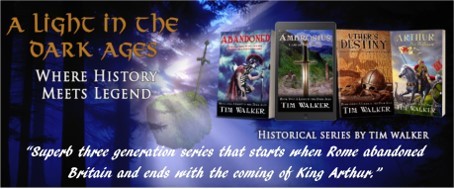
Published on December 11, 2019 19:00
December 10, 2019
#BookReview — Just Get Up:And Manifest Your Inner Genius By Isaac Samuel Miller #Biography #SelfHelp
 Just Get Up: And Manifest Your Inner GeniusBy Isaac Samuel Miller
Just Get Up: And Manifest Your Inner GeniusBy Isaac Samuel Miller
Abandoned by his father at the age of seven, Isaac Miller embarks upon a thirteen-year journey to fight his way out of a life of crime, drugs, mediocrity, and poverty.
Using his teenage imagination and work ethic as his guide, Isaac provides for his family, including his schizophrenic mother, and fights his way to becoming an entrepreneur at the age of seventeen.
Through his story, Isaac demonstrates how you can start with nothing and still live your dreams. Just Get Up teaches you how to capture your own life's dreams through exposing your inner genius. This guided tour of self-development will teach you how to unlock your life's true treasures. It will appeal to all people seeking a real-life inspirational story of overcoming adversities.
Along your journey you will find The Limelight Spot Effect, The 27-Month Plan, and The Octagon Way as you build your own success through his Just Get Up program. Isaac invites you to Just Get Up and tap into your unlimited potential as you discover your inner genius one chapter at a time.

“When others doubt you, it’s okay, because it’s your dream to pursue, not theirs.”
This, I felt, was one of the most profound sentences in Just Get Up: And Manifest Your Inner Genius by Isaac Samuel Miller, and it sums up everything about this book. Just Get Up: And Manifest Your Inner Genius is a motivational guide that encourages you to not only take responsibility for the choices that you make but, more importantly, it shows you how to take control of your life and how to achieve your life goals.
Just Get Up: And Manifest Your Inner Genius is a candid, very genuine, book. Miller delves deep into his poverty-stricken childhood to emphasise not only where he came from, but how he pulled himself out of the poverty-trap that he and his family were in. Not only did Miller follow his dreams, but he made them come true through hard work and dedication. These captivating personal anecdotes give those who read this book hope that they too can follow his example and live the life that their heart truly desires.
If you want to get the most out of Just Get Up: And Manifest Your Inner Genius, then you need to read it in full, without skipping over any of the chapters. Each chapter builds on what comes before it, which made the lessons that Miller is teaching easy to understand. Miller encourages you to reason with your emotions, and look at them logically and with conscious thought. His analogy of a shadow worked exceptionally well and focused the mind on the understanding that your shadow is unsubstantial and most of the time behind you.
Miller speaks and explains many things in this book. I thought his analogy of what The Limelight Spot Effect is, made a lot of sense. Likewise, Octagon Way, Numbers Don’t Lie, and the 27-Month Plan was incredibly thought-provoking and are certainly worthy of consideration if you want to achieve your dreams. But, this is not a quick-fix book, Miller clearly states to get to where you want to be takes time and a considerable rewiring, in want of a better word, on how you perceive the world. He implores his readers to stop following Life’s GPS (Global Positioning System) and instead follow your own heart's GPS.
Miller emphasises, throughout this book, that you must get yourself out of the mindset that modern living has so assuredly convinced us is correct. Miller states that to have a ‘successful life’ is not about being admired, it is about what is required for you to achieve what you want to achieve. Miller makes a valid point by stating if you don’t do this, you will become your own worst enemy. He also says that you are only a failure if you stop moving forward — stop trying. Such words of wisdom were precisely what I needed to hear.
Miller backs up his points by looking at the history of some very successful people (both dead and still living) to demonstrate how they achieved their success by following what their heart was telling them. The historical people he speaks of are all household names, such as Albert Einstein, Martin Luther King Jr and others... But he also describes how Arnold Schwarzenegger and Oprah Winfrey achieved their goals, which I thought was very enlightening, as well as encouraging.
Miller also encourages his readers to find balance in their lives. And more importantly, make time for the essential things. Miller urges you to put in your diary time for work, family, rest and play. I had never thought of actually writing down such things in my diary, but from now on, I will! I believe this is a simple yet handy tool to help you organise your time.
Miller is a man of deep faith and his relationship with God is evident throughout this book. He takes relevant passages from the Bible to support his argument. With God in mind, the stories Miller uses to articulate his point are almost parables in the telling, which worked exceptionally well in the context of this book. It is so much easier to visualise what Miller was trying to convey when he used stories to demonstrate his message.
Just Get Up: And Manifest Your Inner Genius is a book that you need to have pen and paper with you while you read. I found myself jotting down notes and highlighting particular passages that I found interesting and noteworthy. There are also several exercises in this book, and I thought they were not only thought-provoking, but they kept me directed as to what I wanted to achieve. I believe these are exercises that I will come back to again. This is an incredibly encouraging book, with a bright light of hope shimmering through the pages and giving confidence to the soul.
As Miller so elegantly writes:
“Stop dating your dreams and go certify your true love by marrying your dreams.”
Just Get Up: And Manifest Your Inner Genius is a book worthy of your attention... It is also an essential one if you want to turn your life around and follow those dreams you dared not follow before.
I Highly Recommend.
Review by Mary Anne Yarde.The Coffee Pot Book Club.
Pick up your copy ofJust Get Up:And Manifest Your Inner GeniusAmazon UK • Amazon US
Isaac Samuel Miller
 Isaac Samuel Miller is the author of Just Get Up: And Manifest Your Inner Genius and he has a collaborative book entitled, Experts & Influencers: The Leadership Edition. When Isaac turned 11 he was determined to provide for his sick mom and to escape poverty, so he set out on a journey to fight his way to success. Eventually this led to Isaac becoming an entrepreneur at 17 years of age. Isaac has over 13 years of experience as an entrepreneur and he works as a licensed strength & conditioning fitness trainer, sales coach, and a motivational speaker. Isaac has a bachelor's degree in therapeutic recreation & leisure studies along with a minor in physical education. Isaac is an active member in his community, he gives his time freely through preaching and delivering various bible discourses as a Minister. Isaac is a spoken word artist and he inspires people internationally with his spoken word piece entitled, Self-Belief. Isaac loves to inspire people and he invites the world to listen to his podcast entitled, JustGetUpWithIsaacfor daily inspiration.
Isaac Samuel Miller is the author of Just Get Up: And Manifest Your Inner Genius and he has a collaborative book entitled, Experts & Influencers: The Leadership Edition. When Isaac turned 11 he was determined to provide for his sick mom and to escape poverty, so he set out on a journey to fight his way to success. Eventually this led to Isaac becoming an entrepreneur at 17 years of age. Isaac has over 13 years of experience as an entrepreneur and he works as a licensed strength & conditioning fitness trainer, sales coach, and a motivational speaker. Isaac has a bachelor's degree in therapeutic recreation & leisure studies along with a minor in physical education. Isaac is an active member in his community, he gives his time freely through preaching and delivering various bible discourses as a Minister. Isaac is a spoken word artist and he inspires people internationally with his spoken word piece entitled, Self-Belief. Isaac loves to inspire people and he invites the world to listen to his podcast entitled, JustGetUpWithIsaacfor daily inspiration.<!-- /* Font Definitions */ @font-face {font-family:"Cambria Math"; panose-1:2 4 5 3 5 4 6 3 2 4; mso-font-charset:0; mso-generic-font-family:roman; mso-font-pitch:variable; mso-font-signature:-536870145 1107305727 0 0 415 0;} /* Style Definitions */ p.MsoNormal, li.MsoNormal, div.MsoNormal {mso-style-unhide:no; mso-style-qformat:yes; mso-style-parent:""; margin:0cm; margin-bottom:.0001pt; mso-pagination:widow-orphan; font-size:12.0pt; font-family:"Times New Roman",serif; mso-fareast-font-family:"Times New Roman";} h1 {mso-style-priority:9; mso-style-unhide:no; mso-style-qformat:yes; mso-style-link:"Heading 1 Char"; mso-margin-top-alt:auto; margin-right:0cm; mso-margin-bottom-alt:auto; margin-left:0cm; mso-pagination:widow-orphan; mso-outline-level:1; font-size:24.0pt; font-family:"Times New Roman",serif; mso-fareast-font-family:"Times New Roman"; font-weight:bold;} a:link, span.MsoHyperlink {mso-style-priority:99; color:#0563C1; mso-themecolor:hyperlink; text-decoration:underline; text-underline:single;} a:visited, span.MsoHyperlinkFollowed {mso-style-noshow:yes; mso-style-priority:99; color:#954F72; mso-themecolor:followedhyperlink; text-decoration:underline; text-underline:single;} p {mso-style-noshow:yes; mso-style-priority:99; mso-margin-top-alt:auto; margin-right:0cm; mso-margin-bottom-alt:auto; margin-left:0cm; mso-pagination:widow-orphan; font-size:12.0pt; font-family:"Times New Roman",serif; mso-fareast-font-family:"Times New Roman";} span.Heading1Char {mso-style-name:"Heading 1 Char"; mso-style-priority:9; mso-style-unhide:no; mso-style-locked:yes; mso-style-link:"Heading 1"; mso-ansi-font-size:24.0pt; mso-bidi-font-size:24.0pt; font-family:"Times New Roman",serif; mso-ascii-font-family:"Times New Roman"; mso-fareast-font-family:"Times New Roman"; mso-hansi-font-family:"Times New Roman"; mso-bidi-font-family:"Times New Roman"; mso-font-kerning:18.0pt; mso-fareast-language:EN-GB; font-weight:bold;} .MsoChpDefault {mso-style-type:export-only; mso-default-props:yes; font-family:"Calibri",sans-serif; mso-ascii-font-family:Calibri; mso-ascii-theme-font:minor-latin; mso-fareast-font-family:Calibri; mso-fareast-theme-font:minor-latin; mso-hansi-font-family:Calibri; mso-hansi-theme-font:minor-latin; mso-bidi-font-family:"Times New Roman"; mso-bidi-theme-font:minor-bidi; mso-fareast-language:EN-US;} @page WordSection1 {size:595.0pt 842.0pt; margin:72.0pt 72.0pt 72.0pt 72.0pt; mso-header-margin:35.4pt; mso-footer-margin:35.4pt; mso-paper-source:0;} div.WordSection1 {page:WordSection1;} </style> -->
Published on December 10, 2019 21:00
Mistletoe Magic In The Dark Ages by Sharon Bradshaw #History #Christmas @sharonbradshaw0
 Mistletoe Magic In The Dark AgesBy Sharon Bradshaw
Mistletoe Magic In The Dark AgesBy Sharon Bradshaw
I write the 8th century Durstan series about a Monk on Iona. My characters are influenced by the history of their time, tradition, and folk memory. Some converted to Christianity during the early Medieval period in the British Isles (410AD to 1066AD), whilst others continued to follow the Old Gods of their Ancestors. Magic was an everyday occurrence. As was belief in the Otherworld, Elves, and Dragons.
Christmas and Yule Celebrations
Ancient monuments, like Stonehenge, recognised the return of the Sun at Yule. The sarsen stones aligned to the first light of dawn at the winter solstice. Jesus also said in the New Testament of the Bible, that His disciples and Himself were the Light of the World. All were trying to survive the cold and dark of winter, as they waited for the Sun’s rebirth on the 20th to 23rd December, or the 25th for Christ’s birthday. Everyone loved to feast, and listen to a tale next to the fire. Evergreen foliage was gathered from the forest to decorate the Halls, and Churches. Sacred Holly (ilex aquifolium), and Ivy (hedera helix). Holly leaves evoked a memory of the crown of thorns placed on Christ’s head at the crucifixion. Its scarlet berries, His blood. Red was thought to be a charm against evil, so the berries gave protection from the malevolence of the winter season when so many other plants lay dormant or dead.
The Influence of Folk Memory
Stories about the Romans who occupied parts of the British Isles, from 43 to 410AD, may well have survived in folk memory during the early Medieval period. Mithra came with them. He was another God who was born when the Romans celebrated Saturnalia at the winter solstice. A servant was crowned Lord of Misrule, and was known to hold a wild court. They gave a sprig of Holly as a sign of friendship, whilst the Celtic Druids believed it represented the blood of the Goddess. Perhaps there was a tale about a young man who had suffered a violent death at Black Lake? The ancient name for Lindow Moss. He could have died at Beltane, or Yule. Both were linked to fertility, but was he murdered or sacrificed by the Ancestors? No one would have been surprised if he had been Druid, and used the magic of Mistletoe (Viscum Album). Its pollen was part of his last meal.

People believed that Mistletoe could cure epilepsy, give protection from witchcraft, and its milk white berries turn into a fertility potion or aphrodisiac. The Roman Pliny (62-113AD) said in his Natural History, that the Druids thought it was “all healing.” They would cut Mistletoe only at night on the sixth day of the waxing Moon. “First they held a sacred meal under the oak tree, then led forward two white bulls whose horns had never before been bound. A Druid dressed in white climbed the tree and cut the Mistletoe with a golden sickle, letting the sacred plant fall onto a white cloak.” The bulls were sacrificed, and the Mistletoe brewed into a drink to restore fertility.
Someone Kissed Me There
It is still one of our Christmas traditions to kiss under the Mistletoe. A sprig usually hung above a door, and a berry removed with each kiss. “Sitting under the Mistletoe (pale green fairy mistletoe)... Someone came and kissed me there.” This lovely poem by Walter De La Mare (1873-1956) may be linked to the revival of interest in Druidism during the 18th century, or possibly the fertility magic of the Dark Ages at Yule which had survived in folk memory.
Alcuin of York (732-804AD) wrote to the King of Northumbria to complain of debauchery in the Halls, after the Vikings had raided Lindisfarne in 793AD. He attributed God’s anger to it, and the desecration of the monasteries. Nevertheless the celebrations must have differed from Hall to Hall. The same as the God or Gods who were honoured for the return of the light. It would have been an opportunity to eat well again. To have fun, in what for most was a precarious and frightening world.
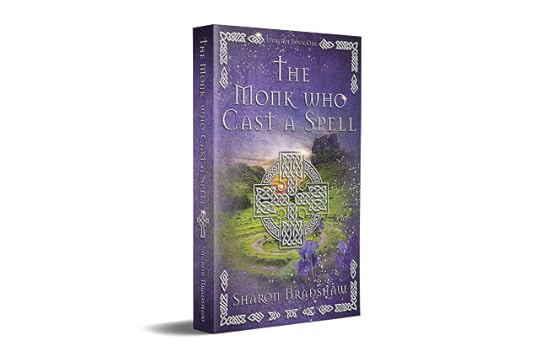
The characters in my novel are about to celebrate Christmas and Yule in this extract from The Monk Who Cast A Spell. Like the other men and women of their time... They love to feast!
The Monk Who Cast a SpellBy Sharon Bradshaw
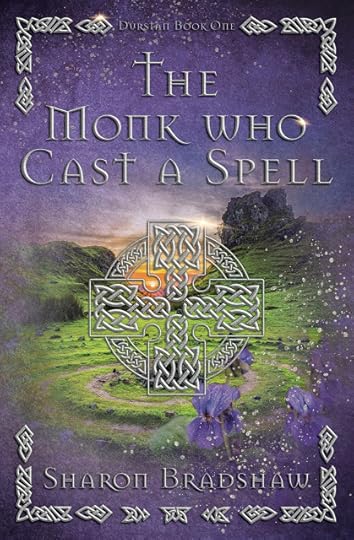
Durstan, a young Monk, falls in love with Ailan in 794AD. She disappears after their sexual awakening at Beltane. He is shocked and confused when he meets her again, several months later. Beth believes that she can obtain the protection of the Christian Church by manipulating Durstan’s emotions, and he is drawn to her.Their story unfolds against the beautiful scenery of Scotland’s Hebridean islands. People cross the sea in coracles from Iona to Mull. They walk through ancient forest to Lord Duncan’s Hall inside its timber enclosure. The seasons change from Spring to mid-Winter when the Old Gods are in the magic of the firelight, and the shadows at Yule.The early Christian Church continues to be challenged by tradition, and the Druids. Charms, amulets, and spells are prevalent. Life at the monastery is harsh, and Durstan is involved in the Viking raids. He doubts his religious beliefs in a society which is dominated by fear of violence, being outcast, or enslaved. Men and women in the 8th century are seeking protection from the most powerful God; Lord, or Abbot.And Durstan’s quest? To regain Ailan’s love.
Excerpt
“It was snowing heavily, and the Yule feast was in progress. Everyone at the enclosure had left their own hearth to celebrate the solstice with Lord Duncan. A huge log had been brought in yesterday from the forest. It was burning in the fire pit at the centre of the Hall, and the flames cast a cheerful glow all around.
Mora felt a sense of pride when she saw the number of people at the gathering, but this was quickly followed by disgust at how badly some of her husband’s people were behaving. Kisses and more were being exchanged freely. It was the fault of little else to do in winter, and too much feasting. After this there would soon be Beltane, when the Gods allowed them again to be with anyone they chose. No wonder handfasting didn’t last long. Mora stroked the fine cloth on the sleeve of her tunic. She was fortunate to be married to the Lord...
She had celebrated Beltane with the others only once since her marriage. Duncan said afterwards that it wasn’t for her as the Lord’s Lady. It gave too many men the opportunity of getting closer to him so he forbade it. Her heart died a little every year when he went with the women into the forest, to celebrate the fertility of the earth...
She sipped her wine appreciatively. The women had tried their best to look festive for the feast. A few had saved new tunics made during the summer weaving. They had died them burnt gold, and leaf green. The Hall looked beautiful, with half the forest seemingly brought in by the men in fragrant branches of pine and holly…. Mora was proud to have the finest clothes at the enclosure.”
Pick up your copy ofThe Monk Who Cast a SpellAmazon
Sharon Bradshaw
 Sharon Bradshaw is a Historical Fiction Author, Storyteller, and Poet. She loves reading archaeology books, and delving into the 8th century to write the Durstan series. The Monk Who Cast a Spell, available now on Amazon is set in the real Middle Earth we called the Dark Ages. Subscribers to The Storyteller’s Newsletterreceive a free short story from her every month.
Sharon Bradshaw is a Historical Fiction Author, Storyteller, and Poet. She loves reading archaeology books, and delving into the 8th century to write the Durstan series. The Monk Who Cast a Spell, available now on Amazon is set in the real Middle Earth we called the Dark Ages. Subscribers to The Storyteller’s Newsletterreceive a free short story from her every month. Sharon also enjoys speaking about her novels, and how all this came about. She lives with her family and a large collection of books, near Warwick Castle, in the UK.
Please visit her Website for more information, and follow her on Facebook and Twitter.
Published on December 10, 2019 19:00
December 9, 2019
#BookReview — Antonius: Second in Command (Antonius Trilogy, #2) by Brook Allen #HistoricalFiction #AncientRome @1BrookAllen
 Antonius: Second in Command(Antonius Trilogy, #2)By Brook Allen
Antonius: Second in Command(Antonius Trilogy, #2)By Brook Allen
Having proven himself as a formidable cavalry commander, Marcus Antonius finally earns a position at his kinsman Julius Caesar’s side. However, Caesar is an exacting general, demanding complete allegiance from his staff, even when his decisions put him at odds with the Senate. Marcus’s loyalty to Caesar comes at a cost, and he soon finds himself embroiled in mob violence and military mutinies. As civil war brings Rome’s Republic crashing down, many a relationship is torn asunder, including Marcus’s marriage. Determined to rise triumphant in Rome’s new era, Marcus faces his fears, his failures, and his enemies—not the least of whom is himself.
Amid the crisis of the Ides of March, Marcus must don the mantle of ruthlessness to carve his own legacy in Rome’s history. Enemies have been made, wills have been read, and heirs proclaimed.
But in Rome’s civil unrest, blood answers only to blood.

"Please consider joining my staff as a legate. Should you accept, report personally to me at Portus Itius..."
Should he accept? Did Caesar really need to ask? Caesar had made Marcus Antonius a legate, regardless that he had never held office in the Senate. Marcus was to join Caesar and fight in his Gallic campaign. To be given such an honour was what Marcus had always dreamed of. Perhaps, at last, after his own father had failed the Senate, his stepfather had been seized and executed by the state, and his uncle had been shamed and sent into exile, Marcus could restore his family's name.
However, some said that Caesar's war was illegal, while others feared his true intentions. And Marcus would learn soon enough that loyalty to Caesar would come at a terrible cost to himself.
From the birth of a child to that fateful Ides of March and the desperate fight for power that was to follow, Antonius: Second in Command (Antonius Trilogy, #2) by Brook Allen is a historical fiction triumph.
As I read, I felt the ground tremble under the hooves of the Roman cavalry. I heard the desperate battle cries of the legions, and I smelt the carnage of battle. The despair of a siege, the hunger of an army whose supplies had not come, the acute anxiety of trying to win a battle at sea, the fear, the pain, the desire to be anywhere but where they were — all of this, I felt and more. This was a time of civil war, unrest, and despairing loyalty to a man who wanted power, while the Gods watched on despondently. And in the centre of it all was Marcus Antonius, whose loyalty to Caesar should have been without question, yet his enemies, desperate to bring Marcus down, would do anything and everything to make Caesar doubt his favourite kinsman. But such doubt meant that Caesar chose another as heir. Oh my, Allen has really outdone herself. We all know the story of how Caesar was betrayed and assassinated in the Senate. Allen has retold this story through the eyes of Marcus Antonius, and what a story it is.
Allen has vividly brought to life this time and these people with her elegant prose and her vivid descriptions. Allen's attention to detail has to be commended, and nothing was beyond the telling. The graphic battle scenes evoked the horrors of what it was like for those who fought for Rome and Caesar. As the Republic quivered on its last legs before eventually crashing down with the destruction of a tsunami, Allen has described in detail the absolute misery of civil war. Allen has also depicted the duplicity and the hypocrisy of the political climate. This was a time where one had to befriend an enemy and make enemies of friends. For a great soldier such as Marcus Antonius, Allen describes his deficiencies as a politician. Although a skilled speaker, his wayward past and his family name do him no credit. He is a friend of the people one moment and then thanks to vicious rumours, the enemy the next. This cut-throat atmosphere, the intimidation, and the threats covered beneath toga-clad decorum was beautifully portrayed throughout this book. It was almost as if I had slipped through a portal and found myself in Rome, watching the events unfold.
As with Book 1, Allen's portrayal of Marcus Antonius is sublime. She has captured the very essence of the man. Allen has not made Marcus Antonius a hero, for not everything he did was heroic, but she has made him very human. Marcus Antonius makes many mistakes, he is at times, completely out of his element, and he struggles with politics and pretending to be someone he isn't. He also has a very turbulent personal life which causes him no end of grief, shame, and regret. I don't think anyone has written such a vivid account of Marcus Antonius as Allen has done. Her devotion to his portrayal has to be commended.
Allen depicts Caesar in a slightly different light when compared to Marcus Antonius. Caesar plucks greats victories out of impossible situations. His determination means that he achieves what he set out to achieve. He gains power, and although he refuses that crown of laurel, he is very much a monarch. Caesar is, however, for someone who is very single-minded, easily led. It was surprising how quick he believed Marcus Antonius meant him harm when it was the complete opposite. As a reader, Allen has shown Marcus Antonius' frustration at Caesar. He did everything Caesar asked him to do and yet...It never seemed to be enough. And in the end, Caesar favoured another in his will. I thought Allen's portrayal was remarkable. Allen doesn't romanticise who Caesar was or what he did, but gave as a valid account as she could have about his personality.
Another character that deserves mention is Gaius Octavius (Augustus). Marcus Antonius instantly dislikes him, and as a reader, so did I. He is a very calculating type of character and a shrewd politician. Allen has obviously spent a long time thinking about how she wanted to portray Octavius, and I think she has done a commendable job. History tells us that there was no love between Octavius and Marcus Antonius. They were bitter rivals whose loyalty to Caesar was really the only thing they had in common.
Marcus Antonius has many enemies in this story, some much closer to home than even he realised, but for most of this novel, he has to pretend friendship, on Caesar's orders, with Marcus Tullius Cicero. Marcus Antonius' hatred runs deep, yet he puts that aside for his loyalty to Caesar runs deeper. Allen has depicted a shrewd politician in Cicero. Allen has a wonderful novelist eye for the human condition. Power corrupts, they say, and it really does in this book. It corrupts absolutely.
If you are looking for your next great historical fiction series set in Ancient Rome, then look no further than the Antonius Trilogy.
I Highly Recommend.
Review by Mary Anne Yarde.The Coffee Pot Book Club.
Pick up your copy ofAntonius: Second in CommandAmazon UK • Amazon US
Brook Allen
 Brook Allen is a Music Educator in a rural community near Roanoke, VA. Aside from her regular classes, she teaches two ensembles, a Chorus and Recorder Consort. Born in Salt Lake City, UT, Brook was raised in Omaha, Nebraska and has lived all over the U.S., from the Pacific Northwest, all the way down to Florida. She graduated with a B.A. in Music Education and has a M. A. in Liberal Studies, with an emphasis on Roman History. Brook is happily married and has two energetic Labrador Retrievers. Voraciously active, she cycles, hikes, and loves to travel.
Brook Allen is a Music Educator in a rural community near Roanoke, VA. Aside from her regular classes, she teaches two ensembles, a Chorus and Recorder Consort. Born in Salt Lake City, UT, Brook was raised in Omaha, Nebraska and has lived all over the U.S., from the Pacific Northwest, all the way down to Florida. She graduated with a B.A. in Music Education and has a M. A. in Liberal Studies, with an emphasis on Roman History. Brook is happily married and has two energetic Labrador Retrievers. Voraciously active, she cycles, hikes, and loves to travel.Connect with Brook: Website • Twitter • Facebook.
Published on December 09, 2019 21:00
Join Historical Fiction author, Deborah Swift, as she takes a loon at Lanterloo and Hoodman Blind – 17th Century Christmas Games #Christmas #History @swiftstory
 Lanterloo and Hoodman Blind – 17thCentury Christmas GamesBy Deborah SwiftTues 25 December 1666 (Christmas Day). “Lay pretty long in bed, and then rose, leaving my wife desirous to sleep, having sat up till four this morning seeing her mayds make mince-pies. I to church, where our parson Mills made a good sermon. Then home, and dined well on some good ribbs of beef roasted and mince pies; only my wife, brother, and Barker, and plenty of good wine of my owne, and my heart full of true joy; and thanks to God Almighty for the goodness of my condition at this day.” Samuel PepysPoor Mrs Pepys, up until four baking! In Pepys’ day the Christmas season was a time to eat well in a season where food was scarce. It is difficult today, in our time of superstores selling strawberries in December, to imagine what a big impact this feast had when food was seasonally determined. But what did people do after their dinner when there was no television or internet? Similar to today, the family might do what most families do, play a game. The game could be cards or dice – even small children gambled in this era, the parents giving them small change or tokens for play. A popular card game was
Lanterloo
which had come over from France most probably with the restoration of the monarchy in 1660. Variations of Loo are still played today, as is
Cribbage
which was created by the English poet Sir John Suckling in the early 17th Century.
Lanterloo and Hoodman Blind – 17thCentury Christmas GamesBy Deborah SwiftTues 25 December 1666 (Christmas Day). “Lay pretty long in bed, and then rose, leaving my wife desirous to sleep, having sat up till four this morning seeing her mayds make mince-pies. I to church, where our parson Mills made a good sermon. Then home, and dined well on some good ribbs of beef roasted and mince pies; only my wife, brother, and Barker, and plenty of good wine of my owne, and my heart full of true joy; and thanks to God Almighty for the goodness of my condition at this day.” Samuel PepysPoor Mrs Pepys, up until four baking! In Pepys’ day the Christmas season was a time to eat well in a season where food was scarce. It is difficult today, in our time of superstores selling strawberries in December, to imagine what a big impact this feast had when food was seasonally determined. But what did people do after their dinner when there was no television or internet? Similar to today, the family might do what most families do, play a game. The game could be cards or dice – even small children gambled in this era, the parents giving them small change or tokens for play. A popular card game was
Lanterloo
which had come over from France most probably with the restoration of the monarchy in 1660. Variations of Loo are still played today, as is
Cribbage
which was created by the English poet Sir John Suckling in the early 17th Century.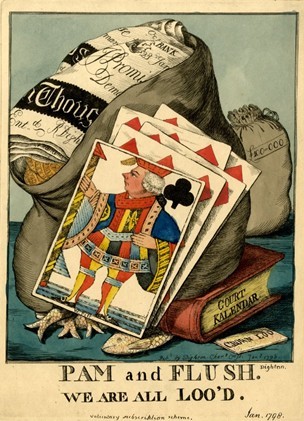
Children might play a game of cratch cradle which we know today as cat’s cradle. Originally the ‘cratch cradle’ represented the manger, or cratch, where Christ was born. "From his cratch to his cross," was a well-known 17th Century phrase meaning from cradle to grave. In the pattern of the string, you can see how this cross-bracing effect looks like a manger.
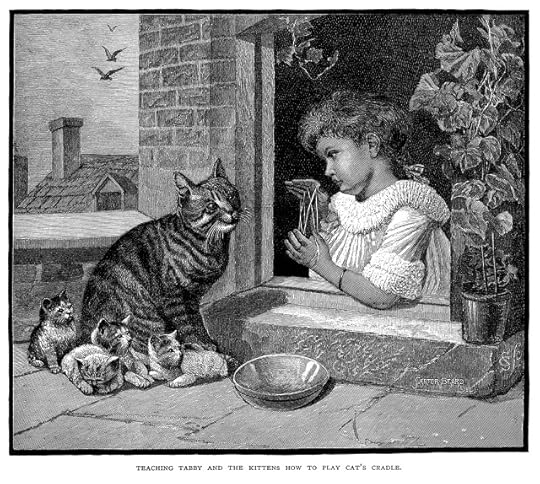
For those looking for a drinking game, how about hijinks ? Players had to roll a dice, and the lowest scoring player would have to take a drink or pay a forfeit. From this we get familiar phrase denoting someone in a high-spirited prank. Another game played in the tavern was John Bull or bullstones , where players would take it in turns tossing coins or stones onto a numbered grid of squares, in an effort to score more points than their neighbour. This was also played by children who would scratch the grid into the dirt to play on the street.A more dangerous game was mumblety-peg which involved throwing a knife at a peg in the ground. The closest to the peg was the winner, but the loser had to extract the peg from the ground with his teeth (English slang - a peg = a tooth). Ouch!Other active games included hoodman-blind , (blind-man’s-buff) and stool-ball which it is believed evolved into cricket. In stool-ball, you had to throw a hard leather ball stuffed with straw or grain at a milking stool. Another person defended it with a wooden bat. The milking stool traditionally had three legs, so you can see how perhaps the cricket ‘stumps’ evolved.
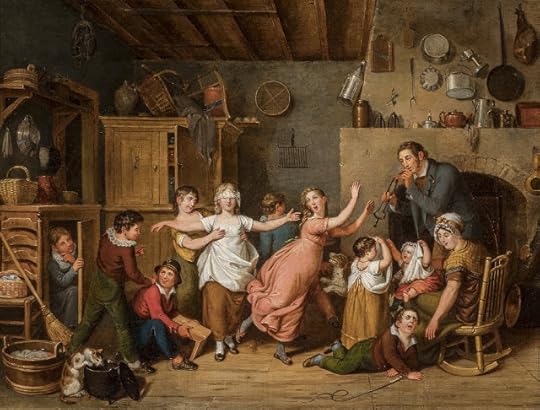 John Lewis Krimmel (1786–1821) Blind Man's Buff, 1814.Was there an equivalent to our ‘charades’? Well charades were not recorded until the 18th Century, but there were always the Mummers. They would go house to house over the Christmas period with their comic plays, full of irreverence for the nobility, the clergy, and anyone in a position of power, for example the doctor. Theatres would also put on plays (though there is no recorded instance of a pantomime until 1717). The old tradition of the Lord of Misrule had died out with the rise of the Puritans in the early 17th century along with many other Christmas traditions. Even after the Restoration of Charles II, it was not re-introduced, as it was feared it was too rowdy and encouraged lewd and unruly behaviour.
John Lewis Krimmel (1786–1821) Blind Man's Buff, 1814.Was there an equivalent to our ‘charades’? Well charades were not recorded until the 18th Century, but there were always the Mummers. They would go house to house over the Christmas period with their comic plays, full of irreverence for the nobility, the clergy, and anyone in a position of power, for example the doctor. Theatres would also put on plays (though there is no recorded instance of a pantomime until 1717). The old tradition of the Lord of Misrule had died out with the rise of the Puritans in the early 17th century along with many other Christmas traditions. Even after the Restoration of Charles II, it was not re-introduced, as it was feared it was too rowdy and encouraged lewd and unruly behaviour.
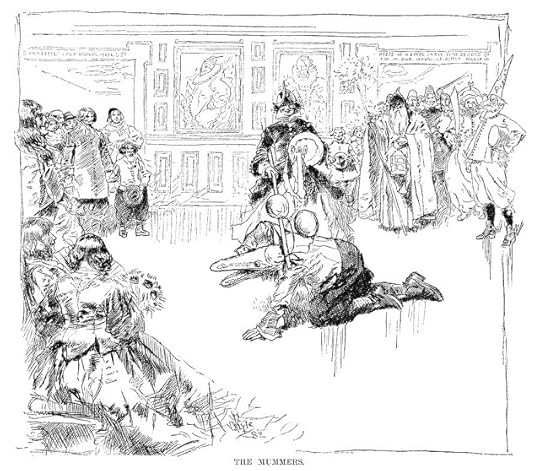
On New Year’s Day though, you could become king and queen for the night. Straws or lots were drawn for the king and queen by the finding of a pea or bean baked in the Twelfth Night cake. The cake was cut so one of the men got the bean and one of the women the pea, and these two could rule over the revels until midnight, when Christmas was officially over.Happy holidays readers – what games do you enjoy playing over the holiday period? As a family we love to play Quirkle and Ingenious as well as the more traditional Monopoly. And of course snuggling down with a good book is always a possibility!
Entertaining Mr Pepys
By Deborah Swift

London 1666Elizabeth 'Bird' Carpenter has a wonderful singing voice, and music is her chief passion. When her father persuades her to marry horse-dealer Christopher Knepp, she suspects she is marrying beneath her station, but nothing prepares her for the reality of life with Knepp. Her father has betrayed her trust, for Knepp cares only for his horses; he is a tyrant and a bully, and will allow Bird no life of her own.When Knepp goes away, she grasps her chance and, encouraged by her maidservant Livvy, makes a secret visit to the theatre. Entranced by the music, the glitter and glamour of the surroundings, and the free and outspoken manner of the women on the stage, she falls in love with the theatre and is determined to forge a path of her own as an actress.But life in the theatre was never going to be straightforward - for a jealous rival wants to spoil her plans, and worse, Knepp forbids it, and Bird must use all her wit and intelligence to change his mind.Based on events depicted in the famous Diary of Samuel Pepys, Entertaining Mr Pepys brings London in the 17th Century to life. It includes the vibrant characters of the day such as the diarist himself and actress Nell Gwynne, and features a dazzling and gripping finale during the Great Fire of London.The third in Deborah Swift's atmospheric trilogy, bringing to life the women in Pepys' Diary. Each novel features a different character and can be read as a stand-alone book.
Pick up your copy of
Entertaining Mr Pepys
Amazon
Deborah Swift
 Deborah Swift is the author of three previous historical novels for adults, The Lady’s Slipper, The Gilded Lily, and A Divided Inheritance, all published by Macmillan/St Martin’s Press, as well as the Highway Trilogy for teens (and anyone young at heart!). Her first novel was shortlisted for the Impress prize for new novelists.
Deborah Swift is the author of three previous historical novels for adults, The Lady’s Slipper, The Gilded Lily, and A Divided Inheritance, all published by Macmillan/St Martin’s Press, as well as the Highway Trilogy for teens (and anyone young at heart!). Her first novel was shortlisted for the Impress prize for new novelists.She lives on the edge of the beautiful and literary English Lake District – a place made famous by the poets Wordsworth and Coleridge.
Connect with Deborah: Website • Facebook • Twitter • Goodreads.
Published on December 09, 2019 20:00
December 8, 2019
#BookReview — Paths to Freedom (The Mallory Saga #2) by Paul Bennett #HistoricalFiction #America @hooverbkreview
 Paths to Freedom (The Mallory Saga #2)By Paul Bennett
Paths to Freedom (The Mallory Saga #2)By Paul Bennett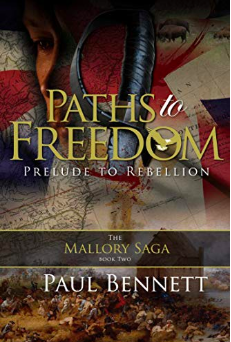
The French and Indian War is over, but the aftermath widens the gulf between the colonies and King George III. A hard handed approach by the King and Parliament fuels the flames of resistance; flames that soon engulf the Mallory clan, consuming the frontier, shattering their hopes for Mallory Town, and changing their lives forever. Revolution is nigh.

"It is time for The Sons of Liberty to show the British the seriousness of our resolve...."
The French and Indian War may well be over, but the debt remained, and someone has to pay for it. Parliament believed it was down to the colonies to bear their share of imperial defence. However, there were some in America who dared to disagree.
For the Mallory brothers, the King and his Parliament were the least of their concerns. Their concerns lay much closer to home and could be summed up by one name — Reverend James Grantham. But even they did not know the extent Grantham was prepared to go to achieve his aims.
As Reverend Grantham tightens the noose around the Mallory family, The Sons of Liberty make their secret revolutionary plans against the British. War was now a whispered promise on the horizon, and the Mallorys would feel the sting of it...
From the apparent tranquillity of Mallory Town, the endless grassland surrounding the Bighorn River, to the weather-worn decks of the ageing warship HMS Jersey, Paths to Freedom (The Mallory Saga #2) by Paul Bennett is the evocative and unforgettable story of one family in the days that were to lead up to the American Revolution.
In Clash of Empires: A Novel of the French Indian War (The Mallory Saga #1) Bennett presented his readers with an intimate retelling of the colonial wars, the likes of which I have not come across since reading James Fenimore Cooper's Last of the Mohicans many years ago. I have been waiting with eager anticipation for the next book in what promised to be a fabulous series. But what I wasn't expecting was this feeling of absolute reverence as I turned that last page, read that last sentence and noted that final full-stop. Paths to Freedom (The Mallory Saga #2) exceeded anything that I expected. It is, without a doubt, one of the most moving and most compelling historical fiction books that I have ever read.
Set in a wild and untamed backdrop that would rival Michael Blake's Dances with Wolves, Paths to Freedom encompasses everything about this era and the people that lived through it. From a small frontier town to the hustle and bustle of Boston, Bennett has captured this historical world with all the elegance and skill of a master bard. The narrative is shamelessly compelling. Bennett is, without a doubt, a vivacious storyteller. This is an enthralling account of an extraordinary period in American history.
Bennett's skill as an author and his tenacious resolve to tell this story the way he wanted to tell it has to be commended. There is a vast cast of characters in this book, but not once did I feel confused as to who everyone was. I did not need to look at the cast list at the front of the book. Bennett has portrayed all of his characters with an almost tangible realism. There was no way, under Bennett's skilful narrative that I was going to confuse who was who. I have to praise Bennett for such a thing as this is terribly challenging to pull off, but he has done it, and he has done it very well. This book is what historical fiction is all about.
There are several notable characters in this book. Liam Mallory, Otetiani to the Mohawk and Snake Slayer to others, was one of my favourite characters in Book #1 and this continued into Book #2. Liam suffers terrible personal loss in this book, and the buffalo once again haunts his dreams. He has to leave his family and his home if he has any chance of finding himself again. Liam's portrayal from start to finish is sublime. I don't want to give away any spoilers, but in the latter half, Liam has an encounter with a buffalo herd, which for me confirmed why I hold Bennet's writing in such high regard. It is a beautifully portrayed scene and utterly unforgettable.
There are several antagonists in this story, and each has their part to play. But the portrayal of Reverend Grantham is the most memorable. Grantham is an ambitious yet evil man who uses God as a weapon to manipulate his congregation and therefore, the town. He makes them submissive, tells them lies, points accusing fingers, to make them fear him and make them comply. The only ones who are not taken in by Grantham are the Mallorys. They see him for who he actually is and Grantham hates them for that. I thought Grantham's portrayal was fabulous. This is an antagonist that the reader can really hate. I loathed him, which I am sure is exactly what Bennett intended all along.
We are introduced to the wonderful escaped slave, Bert Sawyer, in this book. I adored Sawyer. He is a very strong, proud man, who has vowed he will never be a slave again. His relationship with the Mallorys was profoundly moving, and as this story progresses his trust in human nature is restored. This is a character I really loved reading about.
One more character I have to mention is Marguerite Edgerton. Marguerite has more reason to hate the British than anyone, and she is determined to rid them from her country. I loved Marguerite, she is brave, clever, very good at deceiving those she wants to, but at the same time she is very loyal to those she loves. I am really looking forward to reading more about her in the upcoming book.
The portrayal of The Sons of Liberty was majestic. They fought back against what they saw as unfair taxation. There was no way the colonists could represent themselves in Westminster, and therefore how could they oppose this taxation if they did not have a say in it in the first place. Each small step of rebellion, of course, led to what was to become a revolution. Bennett captured the frustration of the key historical characters during this period of history. I thought he brought them all masterfully back to life and I enjoyed reading about their secret meetings and their determination not to be ignored by the King and his Parliament — even if that did mean playing host to a rather famous tea party!
I cannot express adequately in words how great this book is. Bennett has penned a story with an impressive sweep and brilliance. Book #3 cannot come soon enough.
I Highly Recommend.
Review by Mary Anne Yarde.The Coffee Pot Book Club.
Pick up your copy ofPaths to FreedomAmazon UK • Amazon US
Paul Bennett
 Paul’s education was of the public variety and when he reached Junior High he discovered that his future did not include the fields of mathematics or science. This was generally the case throughout his years in school as he focused more on his interest in history; not just the rote version of names and dates but the causes. Paul studied Classical Civilization at Wayne State University with a smattering of Physical Anthropology thrown in for good measure. Logically, of course, Paul spent the next four decades drawing upon that vast store of knowledge working in large, multi-platform data centers, and is considered in the industry as a bona fide IBM Mainframe dinosaur heading for extinction. Paul currently resides in the quaint New England town of Salem, Massachusetts with his wife, Daryl. The three children have all grown, in the process turning Paul’s beard gray, and have now provided four grandchildren; the author is now going bald.
Paul’s education was of the public variety and when he reached Junior High he discovered that his future did not include the fields of mathematics or science. This was generally the case throughout his years in school as he focused more on his interest in history; not just the rote version of names and dates but the causes. Paul studied Classical Civilization at Wayne State University with a smattering of Physical Anthropology thrown in for good measure. Logically, of course, Paul spent the next four decades drawing upon that vast store of knowledge working in large, multi-platform data centers, and is considered in the industry as a bona fide IBM Mainframe dinosaur heading for extinction. Paul currently resides in the quaint New England town of Salem, Massachusetts with his wife, Daryl. The three children have all grown, in the process turning Paul’s beard gray, and have now provided four grandchildren; the author is now going bald.For more information, please visit the Mallory Saga Facebook page. You can also find Paul on his Blog, Twitter, and Goodreads.
Published on December 08, 2019 21:00
Christmas in the time of William the Conqueror by J.P. Reedman #Christmas #History @StoneLord1
 Christmas in the time of William the ConquerorBy J.P. Reedman
Christmas in the time of William the ConquerorBy J.P. ReedmanWilliam’s Christmas Coronation.
1066 was a strange year for England. It was a year of three Kings, Edward the Confessor, Harold—and Harold’s successor, William the Bastard, who had defeated him at Hastings.
William was the illegitimate son of Robert, Duke of Normandy and a woman named Herleva or Arlette, thought to be a tanner or embalmer’s daughter. In 1051, the childless King Edward the Confessor was said to have named him as heir to England as he was Edward’s cousin once removed. And so, a bloody battle for the crown ensued when Edward died with William believing his claim was superior to that of King Harold.
By December of 1066, many were eager to see the new King crowned. Numerous prominent nobles had bent the knee to their new overlord and Edgar the Atheling, a rival claimant, was firmly in William’s possession.A date for the Coronation was set. An auspicious date within the religious calendar. The new King of England would be crowned at Westminster Abbey on Christmas Day.
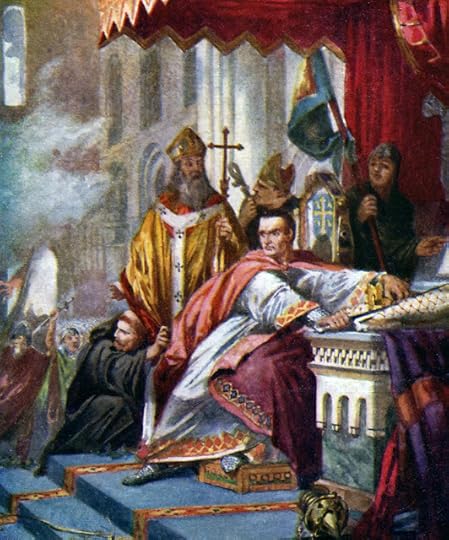
The ceremony was unusual; a blend of English and Norman rituals in an attempt to appease both sides. It took place at the Confessor’s grave and the words were read out both in English by Aeldred, Archbishop of York, and in French by Geoffrey, Bishop of Coutances. The ancient English rite of Saint Dunstan was enacted, but also a rite known to the Kings of France—the anointing of the king with the holy Chrism.
Since rebellion from the English was still a possibility, William had made sure the Abbey was ringed by a band of metal-clad Norman knights, watching for any trouble.
And trouble came—although, as it happened, it was the over-suspicious knights who cause it. Not English rebels.
As the crown about to be settled on William’s Chrism-slick brow, the attendees inside the church began giving out great shouts of acclaim for the new monarch. Their cries shook the vast stone dome, echoing between the pillars. To the Norman knights stationed outside, this shouting sounded like an out-and-out riot, an attack upon their lord from within the church.
Without waiting to find out what was really happening, the Norman knights swarmed into the streets around the Abbey, putting the nearby houses to the torch. Flames leapt into the cold December air.
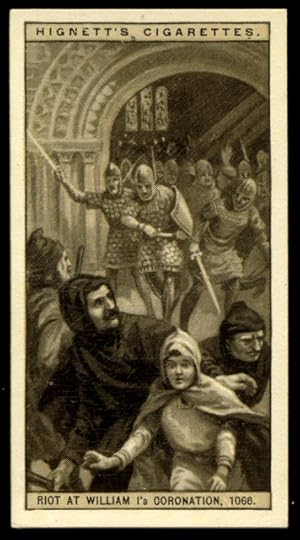
Inside the Abbey, the congregation smelt the acrid smoke and heard screams from those caught in the conflagration beyond. Panicking, they began to surge out of the doors and ran through the smoke-furled streets. Some, seeing the true situation, quickly began to loot the burning shops and houses.
Back within Westminster, William was left with the unnerved bishops, monks and clergy. Apparently even the mighty Conqueror was ‘pale faced and trembling’ in fear, believing that his knights had taken on an unexpected enemy out to dethrone him before he had even been fully crowned.
The Bishops hastily completed the consecration rites while the fires in the houses were extinguished before they could spread further across London. William, now an anointed king, trembled in fear no more but proceeded on his way to the traditional coronation banquet.
However, the events of this day fostered further mistrust between William and the English. Feeling their dissatisfaction, within a few weeks of Christmas, William ordered the beginnings of a huge, impregnable fortress—the edifice that would become the Tower of London.
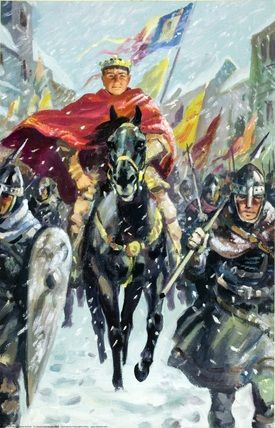
William’s Coronation was not his only memorable Christmas, either. In 1069, on Christmas Day, three years after his Coronation in Westminster, he stood wearing his crown in the roofless, war-ravaged ruins of York Minster—a symbolic act. He then proceeded with the ‘Harrowing of the North’ which left northern England in ruins, with famine gripping the land and thousands homeless or dead. William’s initial tentative peace with the English was over; upon that unhappy Christmas Day in 1069, a new harsher phase of Norman rule had begun.
J.P. Reedman
 J.P. Reedman was born in Canada but has lived in the U.K. for 27 years.Interests include folklore & anthropology, prehistoric archaeology (Neolithic/Bronze age Europe; ritual, burial & material culture), as well as The Wars of the Roses and other medieval periods. Novels include I, Richard Plantagenet, The Man Who Would be King, Secret Marriages (Wars of the Roses), The Hood Game (Robin Hood), The Stonehenge Saga (Bronze Age), and Medieval Babes, an ongoing series about little-known Medieval women.
J.P. Reedman was born in Canada but has lived in the U.K. for 27 years.Interests include folklore & anthropology, prehistoric archaeology (Neolithic/Bronze age Europe; ritual, burial & material culture), as well as The Wars of the Roses and other medieval periods. Novels include I, Richard Plantagenet, The Man Who Would be King, Secret Marriages (Wars of the Roses), The Hood Game (Robin Hood), The Stonehenge Saga (Bronze Age), and Medieval Babes, an ongoing series about little-known Medieval women.J.P.’s most recent release is MY FATHER, MY ENEMY, about William the Conqueror’s granddaughter, Juliane Fitzroy, illegitimate daughter Henry I of England. Married to a Norman noble, life seems set for Juliane until her husband Eustace causes trouble with the castellan of Ivry. Hostages are exchanged by the King's order, Ralph's son for Juliane's daughters. A terrible tragedy happens and Juliane wants vengeance...she wants to kill the King.
My Father, My Enemy:
Juliane, Daughter of Henry I(Medieval Babes, Tales of Little-Known Ladies Book 6)By J.P Reedman

Juliane Fitzroy is the illegitimate daughter of Henry I--one of his twenty-two bastards.
When her father weds her to a young Norman lord, Eustace de Breteuil, she thinks she has done well in life for the daughter of a Saxon concubine.
But Eustace wants a castle he cannot have. He starts hostilities with its castellan, Ralph Harenc, egged on by the dubious Amaury de Montfort.To keep the peace, King Henry orders a hostage exchange between Eustace and Ralph. Juliane's pretty young daughters for Ralph's son.In a drunken rage, fuelled on by Amaury, Eustace breaks the truce and blinds Harenc's boy. Furious, the King allows Ralph to take his own brutal vengeance upon Henry's own granddaughters.
Crazed with grief, Juliane plots revenge for the maiming of her children.
The Wheel of Fate spins. The King must die, his own daughter judge, jury, executioner...
Pick up your copy ofMy Father, My EnemyAmazon UK • Amazon US

Published on December 08, 2019 20:00
December 7, 2019
The Coffee Pot Book Club Book of the Year 2019 goes to — Antonius: Son of Rome by Brook Allen #MustRead #HistoricalFiction #AncientRome @1BrookAllen
The Coffee Pot Book Club
Promoting Historical Fiction since 2015
Book of the Year 2019
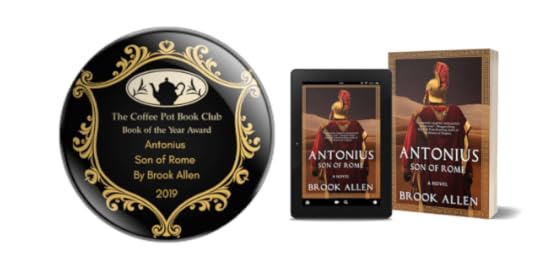
Antonius: Son of Rome By Brook Allen

For over two-thousand years, Marcus Antonius—Marc Antony—has been one of history’s most controversial men. His story was buried with him and written by his enemies. Now his entire saga is revealed in a compelling trilogy by Brook Allen.
After young Marcus Antonius’s father dies in disgrace, he yearns to restore his family’s honor during the final days of Rome’s dying Republic. Marcus is rugged, handsome, and owns abundant military talent, but upon entering manhood, he falls prey to the excesses of a violent society. His whoring, gambling, and drinking eventually reap dire consequences. Through a series of personal tragedies, Marcus must come into his own through blood, blades, and death. Once he finally earns a military commission, he faces an uphill battle to earn the respect and admiration of soldiers, proconsuls, and kings. Desperate to redeem his name and carve a legacy for himself, he refuses to let warring rebels, scheming politicians, or even an alluring young Egyptian princess.
Pick up your copy of
Antonius: Son of Rome
Amazon UK • Amazon US
Brook Allen
 Brook Allen is a Music Educator in a rural community near Roanoke, VA. Aside from her regular classes, she teaches two ensembles, a Chorus and Recorder Consort. Born in Salt Lake City, UT, Brook was raised in Omaha, Nebraska and has lived all over the U.S., from the Pacific Northwest, all the way down to Florida. She graduated with a B.A. in Music Education and has a M. A. in Liberal Studies, with an emphasis on Roman History. Brook is happily married and has two energetic Labrador Retrievers. Voraciously active, she cycles, hikes, and loves to travel.Connect with Brook: Website • Twitter • Facebook.
Brook Allen is a Music Educator in a rural community near Roanoke, VA. Aside from her regular classes, she teaches two ensembles, a Chorus and Recorder Consort. Born in Salt Lake City, UT, Brook was raised in Omaha, Nebraska and has lived all over the U.S., from the Pacific Northwest, all the way down to Florida. She graduated with a B.A. in Music Education and has a M. A. in Liberal Studies, with an emphasis on Roman History. Brook is happily married and has two energetic Labrador Retrievers. Voraciously active, she cycles, hikes, and loves to travel.Connect with Brook: Website • Twitter • Facebook.
Published on December 07, 2019 21:00
December 6, 2019
The Coffee Pot Book Club Box-Set of the Year 2019
The Coffee Pot Book Club
Promoting Historical Fiction since 2015
Box-Set of the Year 2019

Gold

Reschen Valley: Season 1 - 1920-1924 By Chrystyna Lucyk-Berger

Silver

Empire’s Legacy By Marian L Thorpe
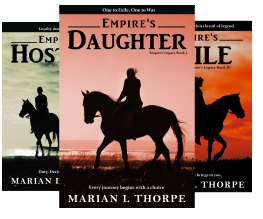
Bronze

The Duchess of Gracechurch Trilogy Box Set By Catherine Kullmann
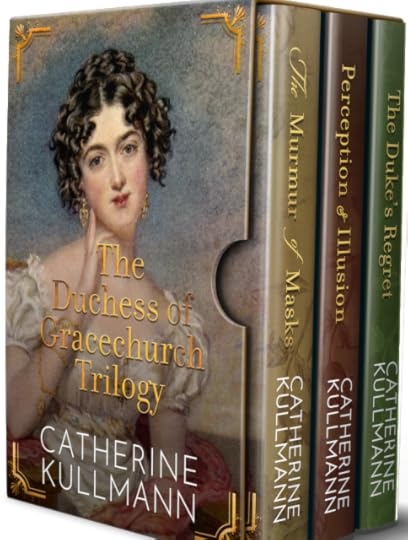
Congratulations to all the winners!
Published on December 06, 2019 21:00
The Coffee Pot Book Club
The Coffee Pot Book Club (formally Myths, Legends, Books, and Coffee Pots) was founded in 2015. Our goal was to create a platform that would help Historical Fiction, Historical Romance and Historical
The Coffee Pot Book Club (formally Myths, Legends, Books, and Coffee Pots) was founded in 2015. Our goal was to create a platform that would help Historical Fiction, Historical Romance and Historical Fantasy authors promote their books and find that sometimes elusive audience. The Coffee Pot Book Club soon became the place for readers to meet new authors (both traditionally published and independently) and discover their fabulous books.
...more
...more
- Mary Anne Yarde's profile
- 159 followers



